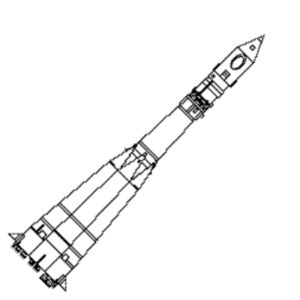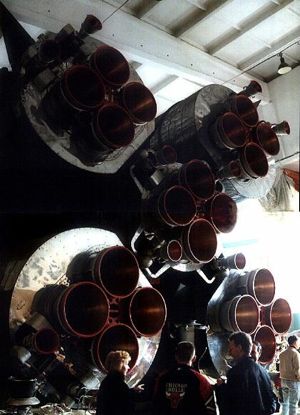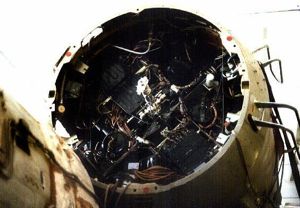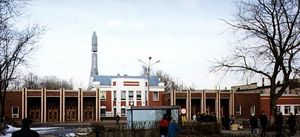Vostok 8K72K (original) (raw)

Home - Search - Browse - Alphabetic Index: 0- 1- 2- 3- 4- 5- 6- 7- 8- 9
A- B- C- D- E- F- G- H- I- J- K- L- M- N- O- P- Q- R- S- T- U- V- W- X- Y- Z
Vostok 8K72K

Vostok 8K72K
8K72K COSPAR 1961-Mu
Russian orbital launch vehicle. R-7 ICBM with single-engine third stage, uprated from Luna launch vehicle and with forward fairing to accommodate Vostok/Zenit sized spacecraft. 8K72K, used for Vostok manned spacecraft launches and the first Zenit launch attempt.
AKA: 8K72K;A-1;Sapwood;SL-3;Vostok. Status: Retired 1964. First Launch: 1960-12-22. Last Launch: 1964-07-10. Number: 13 . Payload: 4,730 kg (10,420 lb). Thrust: 3,894.25 kN (875,462 lbf). Gross mass: 281,375 kg (620,325 lb). Height: 30.84 m (101.18 ft). Diameter: 2.99 m (9.80 ft). Apogee: 200 km (120 mi).
LEO Payload: 4,730 kg (10,420 lb) to a 200 km orbit at 65.00 degrees.
Stage Data - Vostok 8K72K
- Stage 0. 4 x Vostok 8K72K-0. Gross Mass: 43,300 kg (95,400 lb). Empty Mass: 3,710 kg (8,170 lb). Thrust (vac): 970.000 kN (218,060 lbf). Isp: 313 sec. Burn time: 118 sec. Isp(sl): 256 sec. Diameter: 2.68 m (8.79 ft). Span: 2.68 m (8.79 ft). Length: 19.00 m (62.00 ft). Propellants: Lox/Kerosene. No Engines: 1. Engine: RD-107-8D74-1959. Status: Out of Production.
- Stage 1. 1 x Vostok 8K72K-1. Gross Mass: 100,400 kg (221,300 lb). Empty Mass: 6,800 kg (14,900 lb). Thrust (vac): 912.000 kN (205,025 lbf). Isp: 315 sec. Burn time: 301 sec. Isp(sl): 248 sec. Diameter: 2.99 m (9.80 ft). Span: 2.99 m (9.80 ft). Length: 28.00 m (91.00 ft). Propellants: Lox/Kerosene. No Engines: 1. Engine: RD-108-8D75-1959. Status: Out of Production.
- Stage 2. 1 x Vostok 8K72K-2. Gross Mass: 7,775 kg (17,140 lb). Empty Mass: 1,440 kg (3,170 lb). Thrust (vac): 54.520 kN (12,257 lbf). Isp: 326 sec. Burn time: 365 sec. Diameter: 2.56 m (8.39 ft). Span: 2.56 m (8.39 ft). Length: 2.84 m (9.31 ft). Propellants: Lox/Kerosene. No Engines: 1. Engine: RD-0109. Status: Out of Production.
More at: Vostok 8K72K.
Family: orbital launch vehicle. Country: Russia. Engines: RD-0109, RD-107-8D74-1959, RD-108-8D75-1959. Spacecraft: Vostok, Zenit-2 satellite, Elektron-A, Elektron-B. Projects: Elektron. Launch Sites: Baikonur, Baikonur LC1. Stages: Vostok 8K72K-0, Vostok 8K72K-1, Vostok 8K72K-2. Agency: Korolev bureau.
Photo Gallery
 |
Vostok LVCredit: © Mark Wade |
|---|
 |
R-7 aft endCredit: © Mark Wade |
|---|
 |
R-7 forward viewR-7 forward compartmentCredit: © Mark Wade |
|---|
 |
R-7 CutawaysCredit: © Mark Wade |
|---|
 |
RKK EnergiaMain entrance (security check) of RKK Energia complex. Vostok rocket looms in background.Credit: © Mark Wade |
|---|
1960 December 22 - . Launch Site: Baikonur. Launch Complex: Baikonur LC1. LV Family: R-7. Launch Vehicle: Vostok 8K72K. FAILURE: The third stage engine RO-7 failed just after ignition, 425 seconds in to flight.. Failed Stage: 3.
- Korabl-Sputnik - . Payload: Vostok 1K s/n 4. Mass: 4,730 kg (10,420 lb). Nation: Russia. Agency: RVSN. Program: Vostok. Class: Manned. Type: Manned spacecraft. Spacecraft: Vostok. Decay Date: 1960-12-20 .
Unable to reach orbital velocity, the Vostok prototype separated while the third stage was still firing. While the ejection seat failed to operate, the capsule did make a hard landing in severe winter conditons in Siberia. It was recovered after some time, and the dogs Kometa and Shutka were alive. As a result of this flight the ejection seat was developed with a heat shield designed to protect the pilot in the event of a launch vehicle failure up to shut down of the first stage. Additional Details: here....
1961 March 7 - . LV Family: R-7. Launch Vehicle: Vostok 8K72K.
- R-7 Failure Commission - . Nation: Russia. Related Persons: Bogomolov, Glushko, Keldysh, Korolev, Kosberg, Sokolov. Program: Vostok. Flight: Vostok 1. Spacecraft: Vostok.
Keldysh, Korolev, Sokolov, Glushko, Bogomolov hear testimony from Kosberg on the causes of the RO-7 engine failure on the 22 December 1960 launch, that resulted in the suborbital flight of the Vostok capsule with a landing in Tura. The causes are not completely understood, but the bottom line is that a fuel line must have leaked. Further testimony is offered on the booster trajectory, landing time at various points along the trajectory, tracking station readiness, communications lessons, and recovery efforts. The communications are clearly unreliable. The radius of the HF radio is 5000 km, and 1500 km for UHF. TsP Moscow and PU Tyuratam, plus Novosibirsk, Kolpachev, Khabarovsk, and Yelizov (Kamchatka) all have HF and UHF transceivers. But due to practical reception problems, only UHF communications were available at Tyuratam, Kolpachev, and Yelizov, and only HF at Novosibirsk and Khabarovsk. It is recommended that each IP tracking station should have a Chief Communications Officer, a cosmonaut to act as capsule communicator, a physician, and a representative from the Ministry of Communications to assure action on problems.
1961 March 9 - . 06:29 GMT - . Launch Site: Baikonur. Launch Complex: Baikonur LC1. LV Family: R-7. Launch Vehicle: Vostok 8K72K.
- Korabl-Sputnik 4 - . Payload: Vostok 3KA s/n 1. Mass: 4,700 kg (10,300 lb). Nation: Russia. Related Persons: Mozzhorin, Yazdovskiy. Agency: RVSN. Program: Vostok. Class: Manned. Type: Manned spacecraft. Flight: Vostok 1. Spacecraft: Vostok. Duration: 0.0700 days. Decay Date: 1961-03-09 . USAF Sat Cat: 91 . COSPAR: 1961-Theta-1. Apogee: 239 km (148 mi). Perigee: 173 km (107 mi). Inclination: 64.90 deg. Period: 88.60 min.
Carried dog Chernushka, mannequin Ivan Ivanovich, and other biological specimens. Ivanovich was ejected from the capsule and recovered by parachute, and Chernsuhka was successfully recovered with the capsule on March 9, 1961 8:10 GMT.
Officially: Development of the design of the space ship satellite and of the systems on board, which ensure necessary conditions for man's flight. Additional Details: here....
1961 March 22 - . LV Family: R-7. Launch Vehicle: Vostok 8K72K.
- Flight preparations - . Nation: Russia. Related Persons: Barmin, Gagarin, Keldysh, Korolev, Nelyubov, Titov. Program: Vostok. Flight: Vostok 1.
Between 10:00 and 12:00 Chief Designer of Launch Facilities Barmin meets with the cosmonauts. He reviews the launch mechanism. The rocket is suspended at the 'shoulders' of the strap-ons, on four swivelled supports. After the rocket has lifted 49 mm, it is free from these, and counterweights weighing dozens of tonnes will swing them back and away from the rising booster. At 12:00 Kamanin meets with Keldysh and Korolev. They agree with his position that the flight be announced as soon as the cosmonaut is safely in orbit.
1961 March 25 - . 05:54 GMT - . Launch Site: Baikonur. Launch Complex: Baikonur LC1. LV Family: R-7. Launch Vehicle: Vostok 8K72K.
- Korabl-Sputnik 5 - . Payload: Vostok 3KA s/n 2. Mass: 4,695 kg (10,350 lb). Nation: Russia. Related Persons: Bykovsky, Gagarin, Goreglyad, Kamanin, Karpov, Keldysh, Kirillov, Korolev, Nelyubov, Nikolayev, Popovich, Titov, Voskresenskiy, Yazdovskiy. Agency: RVSN. Program: Vostok. Class: Manned. Type: Manned spacecraft. Flight: Vostok 1. Spacecraft: Vostok. Duration: 0.0600 days. Decay Date: 1961-03-25 . USAF Sat Cat: 95 . COSPAR: 1961-Iota-1. Apogee: 175 km (108 mi). Perigee: 175 km (108 mi). Inclination: 64.90 deg. Period: 88.00 min.
Carried dog Zvezdochka and mannequin Ivan Ivanovich. Ivanovich was again ejected from the capsule and recovered by parachute, and Zvezdochka was successfully recovered with the capsule on March 25, 1961 7:40 GMT.
Officially: Development of the design of the space ship satellite and of the systems on board, designed to ensure man's life functions during flight in outer space and return to Earth. Additional Details: here....
1961 April 12 - . 06:07 GMT - . Launch Site: Baikonur. Launch Complex: Baikonur LC1. LV Family: R-7. Launch Vehicle: Vostok 8K72K.
- Vostok 1 - . Call Sign: Kedr (Cedar ). Crew: Gagarin. Backup Crew: Nelyubov, Titov. Payload: Vostok 3KA s/n 3. Mass: 4,725 kg (10,416 lb). Nation: Russia. Related Persons: Karpov, Keldysh, Korolev, Moskalenko, Rudnev. Agency: RVSN. Program: Vostok. Class: Manned. Type: Manned spacecraft. Flight: Vostok 1. Spacecraft: Vostok. Duration: 0.0750 days. Decay Date: 1961-04-12 . USAF Sat Cat: 103 . COSPAR: 1961-Mu-1. Apogee: 315 km (195 mi). Perigee: 169 km (105 mi). Inclination: 65.00 deg. Period: 89.30 min.
First manned spaceflight, one orbit of the earth. Three press releases were prepared, one for success, two for failures. It was only known ten minutes after burnout, 25 minutes after launch, if a stable orbit had been achieved.
The payload included life-support equipment and radio and television to relay information on the condition of the pilot. The flight was automated; Gagarin's controls were locked to prevent him from taking control of the ship. The combination to unlock the controls was available in a sealed envelope in case it became necessary to take control in an emergency. After retrofire, the service module remained attached to the Sharik reentry sphere by a wire bundle. The joined craft went through wild gyrations at the beginning of re-entry, before the wires burned through. The Sharik, as it was designed to do, then naturally reached aerodynamic equilibrium with the heat shield positioned correctly.
Gagarin ejected after re-entry and descended under his own parachute, as was planned. However for many years the Soviet Union denied this, because the flight would not have been recognized for various FAI world records unless the pilot had accompanied his craft to a landing. Recovered April 12, 1961 8:05 GMT. Landed Southwest of Engels Smelovka, Saratov. Additional Details: here....
1961 August 6 - . 06:00 GMT - . Launch Site: Baikonur. Launch Complex: Baikonur LC1. LV Family: R-7. Launch Vehicle: Vostok 8K72K.
- Vostok 2 - . Call Sign: Oryel (Eagle ). Crew: Titov. Backup Crew: Nelyubov, Nikolayev. Payload: Vostok 3KA s/n 4. Mass: 4,730 kg (10,420 lb). Nation: Russia. Agency: RVSN. Program: Vostok. Class: Manned. Type: Manned spacecraft. Flight: Vostok 2. Spacecraft: Vostok. Duration: 1.00 days. Decay Date: 1961-08-07 . USAF Sat Cat: 168 . COSPAR: 1961-Tau-1. Apogee: 221 km (137 mi). Perigee: 172 km (106 mi). Inclination: 64.80 deg. Period: 88.40 min.
Second manned orbital flight. The Soviet Union successfully launched Vostok II into orbit with Gherman S. Titov as pilot. The spacecraft carried life-support equipment, radio and television for monitoring the condition of the cosmonaut, tape recorder, telemetry system, biological experiments, and automatic and manual control equipment. Flight objectives: Investigation of the effects on the human organism of a prolonged flight in orbit and subsequent return to the surface of the Earth; investigation of man's ability to work during a prolonged period of weightlessness. Titov took manual control of spacecraft but suffered from space sickness. He was equipped with a professional quality Konvas movie camera, with which ten minutes of film of the earth were taken through the porthole. Both television and film images were taken of the interior of the spacecraft. Like Gagarin, Titov experienced problems with separation of the service module after retrofire. Titov was never to fly again, after being assigned to the Spiral spaceplane, which turned out to be a dead-end project. A biography of him by Martin Caidin ('I Am Eagle') made him somewhat more accessible than Gagarin to the West.
1961 December 11 - . 09:39 GMT - . Launch Site: Baikonur. Launch Complex: Baikonur LC1. LV Family: R-7. Launch Vehicle: Vostok 8K72K. FAILURE: RO-7 engine of block E upper stage cutoff prematurely. Spacecraft liquidated by self destruct system APO in 407th second of flight. Debris landed 100 km north of Vilyuisk.. Failed Stage: 2.
- Zenit-2 11F61 s/n 1 - . Payload: Zenit-2 11F61 s/n 1. Mass: 4,610 kg (10,160 lb). Nation: Russia. Agency: RVSN. Class: Surveillance. Type: Military surveillance satellite. Spacecraft Bus: Vostok. Spacecraft: Zenit-2 satellite. Decay Date: 1961-12-11 .
First attempted launch of Zenit photo-reconnaisance satellite. According to Kamanin, there was a problem with the third stage, and the capsule landed between Novosibirsk and Yakutsk, but could not be located. There was no information on the nature of the problem. Korolev stayed at Tyuratam, preparing for the next launch attempt.
1962 April 26 - . 10:02 GMT - . Launch Site: Baikonur. Launch Complex: Baikonur LC1. LV Family: R-7. Launch Vehicle: Vostok 8K72K.
- Cosmos 4 - . Payload: Zenit-2 11F61 s/n 2. Mass: 4,610 kg (10,160 lb). Nation: Russia. Related Persons: Nikolayev, Popovich. Agency: RVSN. Class: Surveillance. Type: Military surveillance satellite. Flight: Vostok 3, Vostok 4. Spacecraft Bus: Vostok. Spacecraft: Zenit-2 satellite. Duration: 3.00 days. Decay Date: 1962-04-29 . USAF Sat Cat: 287 . COSPAR: 1962-Xi-1. Apogee: 317 km (196 mi). Perigee: 285 km (177 mi). Inclination: 65.00 deg. Period: 90.50 min.
Area survey photo reconnaissance satellite. Program partially completed. Failure of primary spacecraft orientation system. It was to spend four days in space, to be followed by another mission during 5-10 May. This meant that Vostok 3/4 could not be launched before 20-30 May. The cosmonaut prime crew returned from their in-suit parachute training at Fedosiya.
1962 August 11 - . 08:30 GMT - . Launch Site: Baikonur. Launch Complex: Baikonur LC1. LV Family: R-7. Launch Vehicle: Vostok 8K72K.
- Vostok 3 - . Call Sign: Sokol (Falcon ). Crew: Nikolayev. Backup Crew: Bykovsky, Volynov. Payload: Vostok 3KA s/n 5. Mass: 4,722 kg (10,410 lb). Nation: Russia. Related Persons: Barmin, Gagarin, Khrushchev, Kirillov, Kozlov, Frol, Popovich, Smirnov, Ustinov. Agency: RVSN. Program: Vostok. Class: Manned. Type: Manned spacecraft. Flight: Vostok 3. Spacecraft: Vostok. Duration: 3.93 days. Decay Date: 1962-08-15 . USAF Sat Cat: 363 . COSPAR: 1962-A-Mu-1. Apogee: 218 km (135 mi). Perigee: 166 km (103 mi). Inclination: 65.00 deg. Period: 88.30 min.
Joint flight with Vostok 4. The first such flight, where Vostok capsules were launched one day apart, coming within a few kilometers of each other at the orbital insertion of the second spacecraft. The flight was supposed to occur in March, but following various delays, one of the two Vostok pads was damaged in the explosion of the booster of the third Zenit-2 reconnsat in May. Repairs were not completed until August. Vostok 3 studied man's ability to function under conditions of weightlessness; conducted scientific observations; furthered improvement of space ship systems, communications, guidance and landing. Immediately at orbital insertion of Vostok 4, the spacecraft were less than 5 km apart. Popovich made radio contact with Cosmonaut Nikolayev. Nikolayev reported shortly thereafter that he had sighted Vostok 4. Since the Vostok had no maneuvering capability, they could not rendezvous or dock, and quickly drifted apart. The launches did allow Korolev to offer something new and different, and gave the launch and ground control crews practice in launching and handling more than one manned spacecraft at a time. The cosmonaut took colour motion pictures of the earth and the cabin interior. Additional Details: here....
1962 August 12 - . 08:02 GMT - . Launch Site: Baikonur. Launch Complex: Baikonur LC1. LV Family: R-7. Launch Vehicle: Vostok 8K72K.
- Vostok 4 - . Call Sign: Berkut (Golden Eagle ). Crew: Popovich. Backup Crew: Komarov, Volynov. Payload: Vostok 3KA s/n 6. Mass: 4,728 kg (10,423 lb). Nation: Russia. Related Persons: Nikolayev. Agency: RVSN. Program: Vostok. Class: Manned. Type: Manned spacecraft. Flight: Vostok 4. Spacecraft: Vostok. Duration: 2.96 days. Decay Date: 1962-08-15 . USAF Sat Cat: 365 . COSPAR: 1962-A-Nu-1. Apogee: 211 km (131 mi). Perigee: 159 km (98 mi). Inclination: 65.00 deg. Period: 88.20 min.
Joint flight with Vostok 3. Acquisition of experimental data on the possibility of establishing a direct link between two space ships; coordination of astronauts' operations; study of the effects of identical spaceflight conditions on the human organism. The launch of Popovich proceeds exactly on schedule, the spacecraft launching with 0.5 seconds of the planned time, entering orbit just a few kilometers away from Nikolayev in Vostok 3. Popovich had problems with his life support system, resulting in the cabin temperature dropping to 10 degrees Centigrade and the humidity to 35%. The cosmonaut still managed to conduct experiments, including taking colour motion pictures of the terminator between night and day and the cabin interior.
Despite the conditions, Popovich felt able to go for the full four days scheduled. But before the mission, Popovich had been briefed to tell ground control that he was 'observing thunderstorms' if he felt the motion sickness that had plagued Titov and needed to return on the next opportunity. Unfortunately he actually did report seeing thunderstorms over the Gulf of Mexico, and ground control took this as a request for an early return. He was ordered down a day early, landing within a few mintutes of Nikolayev. Only on the ground was it discovered that he was willing to go the full duration, and that ground control had thought he had given the code.
1963 June 14 - . 11:58 GMT - . Launch Site: Baikonur. Launch Complex: Baikonur LC1. LV Family: R-7. Launch Vehicle: Vostok 8K72K.
- Vostok 5 - . Call Sign: Yastreb (Hawk ). Crew: Bykovsky. Backup Crew: Leonov, Volynov. Payload: Vostok 3KA s/n 7. Mass: 4,720 kg (10,400 lb). Nation: Russia. Program: Vostok. Class: Manned. Type: Manned spacecraft. Flight: Vostok 5. Spacecraft: Vostok. Duration: 4.96 days. Decay Date: 1963-06-19 . USAF Sat Cat: 591 . COSPAR: 1963-020A. Apogee: 131 km (81 mi). Perigee: 130 km (80 mi). Inclination: 64.90 deg. Period: 87.10 min.
Joint flight with Vostok 6. The Soviet Union launched Vostok 5, piloted by Lt. Col. Valery F. Bykovsky. Two days later Lt. Valentina V. Tereshkova, the first spacewoman, followed in Vostok 6. On its first orbit, Vostok 6 came within about five km of Vostok 5, the closest distance achieved during the flight, and established radio contact. Both cosmonauts landed safely on June 19. The space spectacular featured television coverage of Bykovsky that was viewed in the West as well as in Russia. Unlike earlier missions, only a black and white film camera was carried. Photometric measurements of the earth's horizon were made.
Mission objectives were officially: further study of the effect of various space-flight factors in the human organism; extensive medico-biological experiments under conditions of prolonged flight; further elaboration and improvement of spaceship systems.
Vostok 5 was originally planned to go for a record eight days. The launch was delayed repeatedly due to high solar activity and technical problems. Finally the spacecraft ended up in a lower than planned orbit. Combined with increased atmospheric activity due to solar levels, Vostok 5 quickly decayed temperatures in the service module reached very high levels.
Bykovsky also experienced an unspecified problem with his waste management system (a spill?) which made conditions in the cabin 'very uncomfortable'. He was finally ordered to return after only five days in space.
To top it all off, once again the Vostok service module failed to separate cleanly from the reentry sphere. Wild gyrations ensued until the heat of reentry burned through the non-separating retraining strap.
1963 June 16 - . 09:29 GMT - . Launch Site: Baikonur. Launch Complex: Baikonur LC1. LV Family: R-7. Launch Vehicle: Vostok 8K72K.
- Vostok 6 - . Call Sign: Chayka (Seagull ). Crew: Tereshkova. Backup Crew: Ponomaryova, Solovyova. Payload: Vostok 3KA s/n 8. Mass: 4,713 kg (10,390 lb). Nation: Russia. Related Persons: Korolev. Program: Vostok. Class: Manned. Type: Manned spacecraft. Flight: Vostok 6. Spacecraft: Vostok. Duration: 2.95 days. Decay Date: 1963-06-19 . USAF Sat Cat: 595 . COSPAR: 1963-023A. Apogee: 166 km (103 mi). Perigee: 165 km (102 mi). Inclination: 64.90 deg. Period: 87.80 min.
Joint flight with Vostok 5. First woman in space, and the only Russian woman to go into space until Svetlana Savitskaya 19 years later. On its first orbit, Vostok 6 came within about five km of Vostok 5, the closest distance achieved during the flight, and established radio contact. Flight objectives included: Comparative analysis of the effect of various space-flight factors on the male and female organisms; medico-biological research; further elaboration and improvement of spaceship systems under conditions of joint flight. It was Korolev's idea just after Gagarin's flight to put a woman into space as yet another novelty. Khrushchev made the final crew selection. Korolev was unhappy with Tereshkova's performance in orbit and she was not permitted to take manual control of the spacecraft as had been planned.
1964 January 30 - . 09:45 GMT - . Launch Site: Baikonur. Launch Complex: Baikonur LC1. LV Family: R-7. Launch Vehicle: Vostok 8K72K.
- Elektron 1 - . Payload: 2D s/n 1. Mass: 329 kg (725 lb). Nation: Russia. Agency: Korolev bureau. Program: Elektron. Class: Earth. Type: Magnetosphere satellite. Spacecraft: Elektron-A. USAF Sat Cat: 746 . COSPAR: 1964-006A. Apogee: 6,439 km (4,001 mi). Perigee: 413 km (256 mi). Inclination: 60.90 deg. Period: 161.00 min.
Studied inner Van Allen belt. Electron I and II launched by a single carrier rocket. Electron I: simultaneous study of the Earth's inner and outer radiation belts, cosmic rays and upper atmosphere. Electron II: simultaneous study of the Earth's inner and outer radiation belts, cosmic rays and outer space. - Elektron 2 - . Payload: 2D s/n 2. Mass: 444 kg (978 lb). Nation: Russia. Agency: Korolev bureau. Program: Elektron. Class: Earth. Type: Magnetosphere satellite. Spacecraft: Elektron-B. Decay Date: 1997-04-22 . USAF Sat Cat: 748 . COSPAR: 1964-006B. Apogee: 62,811 km (39,028 mi). Perigee: 5,611 km (3,486 mi). Inclination: 60.20 deg. Period: 1,356.40 min.
Studied outer Van Allen belt. Electron I and II launched by a single carrier rocket. Electron I: simultaneous study of the Earth's inner and outer radiation belts, cosmic rays and upper atmosphere. Electron II: simultaneous study of the Earth's inner and outer radiation belts, cosmic rays and outer space.
1964 July 10 - . 21:51 GMT - . Launch Site: Baikonur. Launch Complex: Baikonur LC1. LV Family: R-7. Launch Vehicle: Vostok 8K72K.
- Elektron 3 - . Payload: 2D s/n 3. Mass: 350 kg (770 lb). Nation: Russia. Agency: Korolev bureau. Program: Elektron. Class: Earth. Type: Magnetosphere satellite. Spacecraft: Elektron-A. USAF Sat Cat: 829 . COSPAR: 1964-038A. Apogee: 6,302 km (3,915 mi). Perigee: 408 km (253 mi). Inclination: 60.90 deg. Period: 159.30 min. Studied inner Van Allen belt. Electron 3 and 4 launched by a single carrier rocket. Simultaneous study of the inner and outer radiation belts of the earth, cosmic rays and the upper atmosphere. .
- Elektron 4 - . Payload: 2D s/n 4. Mass: 444 kg (978 lb). Nation: Russia. Agency: Korolev bureau. Program: Elektron. Class: Earth. Type: Magnetosphere satellite. Spacecraft: Elektron-B. Decay Date: 1983-10-12 . USAF Sat Cat: 830 . COSPAR: 1964-038B. Apogee: 66,269 km (41,177 mi). Perigee: 447 km (277 mi). Inclination: 60.80 deg. Period: 1,313.80 min. Studied outer Van Allen belt. Electron 3 and 4 launched by a single carrier rocket. Simultaneous study of the inner and outer radiation belts of the earth, cosmic rays and the upper atmosphere. .
Home - Search - Browse - Alphabetic Index: 0- 1- 2- 3- 4- 5- 6- 7- 8- 9
A- B- C- D- E- F- G- H- I- J- K- L- M- N- O- P- Q- R- S- T- U- V- W- X- Y- Z
© 1997-2019 Mark Wade - Contact
© / Conditions for Use